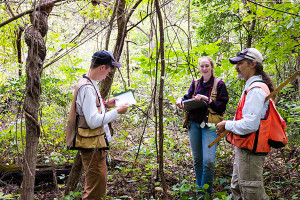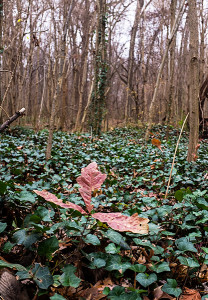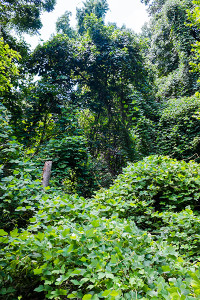Managing our remarkable forest
Today’s Commercial Appeal puts a spotlight on the Midtown Urban Forestry Fellowship, a partnership between Overton Park Conservancy and Rhodes College to develop an inventory of the Old Forest. (Go read it if you haven’t!) The article illustrates a crucial dynamic in forest management: balancing a careful study of the ecosystem with needs that should be immediately addressed. That’s why Overton Park Conservancy has adopted a two-pronged approach to our work: inventory and invasive management.

The Conservancy is working together with the Tennessee Department of Environment and Conservation to develop a State Natural Area Management Plan for the Old Forest. The Rhodes students’ work is crucial in creating a plan that specifically addresses our unique ecosystem. “This forest is so remarkable and under so much pressure from invasives and heavy use,” says Eric Bridges, our Director of Operations. “It’s also small and fragmented, which makes it less resilient to these pressures. That’s why it’s important that we study it well and manage it carefully. This Urban Forestry Fellowship is just the beginning of that process.”
Minding the Gaps
The fellows’ work is especially valuable when considered alongside a 1987 assessment conducted by Dr. James M. Guldin, who recently toured the forest to see what had changed in the last 27 years. His original work noted that many of the large canopy gaps (created when large trees fall and sunlight is let into an area for the first time in many years) did not appear to be regenerating with the oak and poplar trees that give the Old Forest so much of its character. Despite the existence of many large-diameter oaks and poplars, and the presence of a number of 3-5-year-old saplings, the mid-level trees were missing. When Dr. Guldin returned recently, he had hoped to see that those saplings had grown into viable trees, but instead he and Eric found that many of the gaps were in the same condition as they were in the 1980s. Something was holding those trees back from making it to the mid-story, and ultimately to the canopy.

Forest inventories, conducted over time, can help answer questions like, “Why aren’t these trees surviving?” One explanation is that invasive species like kudzu and honeysuckle vine are rapidly populating those gaps, shading out or smothering the small trees. But it may not be that simple. Once all the gaps are mapped and inventoried, our management plan could call for conducting some experiments over time. A sample canopy gap experiment might look like this:
- A control area, where a gap is allowed to fill in with no intervention on our part
- A gap where all invasive species are completely removed
- A gap where the ground is manually worked to scarify seeds and encourage germination
- A gap where seeds harvested from elsewhere in the park are planted
Dr. Guldin and his team noted the lack of advanced regeneration in their 1987 assessment: “Regeneration is not particularly abundant in the understory, as one would hope in stands at this ecological stage…A critical management issue is the securing of regeneration to perpetuate the transitional old-growth forest stand dynamics.” While seed sources appear to be abundant in the canopy gaps, something is interrupting the natural process. The forest inventory will hopefully allow us to quantify the problem so that we can develop an appropriate management strategy to respond.
What We Can Do Now
The forest isn’t in perfect shape, but most of these issues aren’t true emergencies, and we have the benefit of time to study them before responding. But some plants are so invasive, and having such an obvious impact, that the Conservancy continues to act to combat them.

Dr. Guldin’s study states, “Three non-native woody perennials — privet, honeysuckle, and kudzu — have effectively blocked the normal ecological processes by which old-growth stands regenerate themselves.” The City began attacking kudzu several decades ago, and volunteers have persisted in combating it (including a major effort this past summer). Overton Park Conservancy removed more than 2,000 cubic yards of privet in 2012 and 2013. We have begun treating the resprouted privet again this winter, and our crews have been encouraged to see that the new plants haven’t yet produced seeds. With all these invasives, the effort must be ongoing over many years.
“If this breakdown of gap-phase regeneration dynamics is allowed to continue,” Dr. Guldin concluded, “Overton Park will become a static rather than dynamic forest. The forest area a century hence may be nothing but a few scattered overstory trees surrounded by a green sea of sweet-smelling though impenetrable honeysuckle, kudzu, and privet.”
That’s why the City, many dedicated volunteers, and the Conservancy have intervened over the years. In order to preserve our remarkable forest with its over 200 native plant species, supporting numerous other living things, forest management is crucial. And we’re thrilled to work with our partners at Rhodes College to continue uncovering the workings of the Old Forest so that we can preserve its beauty and diversity well into the future.
If you’re interested in reading Dr. Guldin’s full report, you can find it here.
Just a reminder! If you haven’t made your year-end gift to Overton Park Conservancy yet, now is a great time to do so. Gifts toward Conservancy operations are what make projects like the Old Forest inventory possible. Make a donation today.



